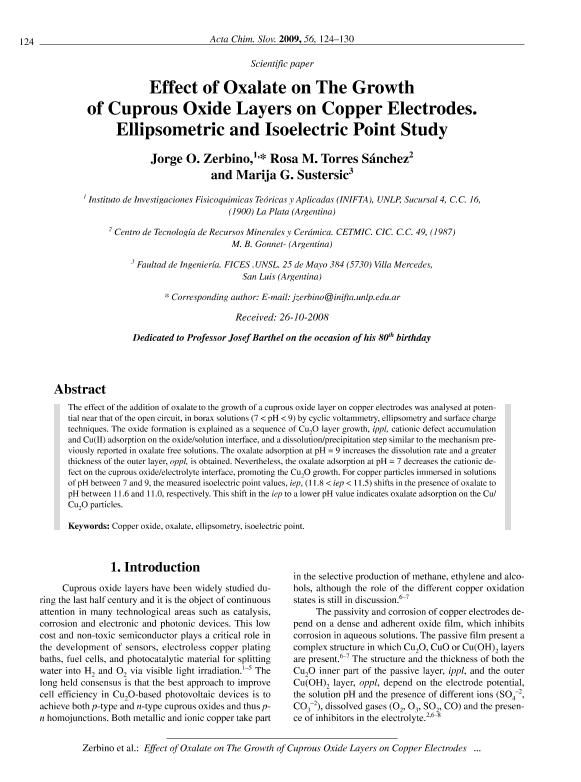Artículo
Effect of oxalate on the growth of cuprous oxide layers on copper electrodes: ellipsometric and isoelectric point study
Fecha de publicación:
12/2009
Editorial:
Slovenian Chemical Society
Revista:
Acta Chimica Slovenica
ISSN:
1318-0207
e-ISSN:
1580-3155
Idioma:
Inglés
Tipo de recurso:
Artículo publicado
Clasificación temática:
Resumen
The effect of the addition of oxalate to the growth of a cuprous oxide layer on copper electrodes was analysed at potential near that of the open circuit, in borax solutions (7 < pH < 9) by cyclic voltammetry, ellipsometry and surface charge techniques. The oxide formation is explained as a sequence of Cu2 O layer growth, ippl, cationic defect accumulation and Cu(II) adsorption on the oxide/solution interface, and a dissolution/precipitation step similar to the mechanism previously reported in oxalate free solutions. The oxalate adsorption at pH = 9 increases the dissolution rate and a greater thickness of the outer layer, oppl, is obtained. Nevertheless, the oxalate adsorption at pH = 7 decreases the cationic defect on the cuprous oxide/electrolyte interface, promoting the Cu2 O growth. For copper particles immersed in solutions of pH between 7 and 9, the measured isoelectric point values, iep, (11.8 < iep < 11.5) shifts in the presence of oxalate to pH between 11.6 and 11.0, respectively. This shift in the iep to a lower pH value indicates oxalate adsorption on the Cu/ Cu2 O particles.
Palabras clave:
COPPER OXIDE
,
OXALATE
,
ELLIPSOMETRIC
,
ISOELECTRIC POINT
Archivos asociados
Licencia
Identificadores
Colecciones
Articulos(CCT - SAN LUIS)
Articulos de CTRO.CIENTIFICO TECNOL.CONICET - SAN LUIS
Articulos de CTRO.CIENTIFICO TECNOL.CONICET - SAN LUIS
Articulos(CETMIC)
Articulos de CENTRO TECNOL.DE REC.MINERALES Y CERAMICA (I)
Articulos de CENTRO TECNOL.DE REC.MINERALES Y CERAMICA (I)
Citación
Zerbino, Jorge Omar; Torres Sanchez, Rosa Maria; Sustersic, Maria Gisela; Effect of oxalate on the growth of cuprous oxide layers on copper electrodes: ellipsometric and isoelectric point study; Slovenian Chemical Society; Acta Chimica Slovenica; 56; 1; 12-2009; 124-130
Compartir




